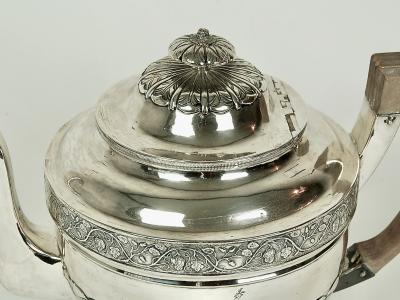Coffee pot
Probably Philadelphia, Pennsylvania
1815-1830
Measurements
9-1/4 in x 12-3/4 in x 7 in (dia)
Materials
Silver, fruitwood (handle)
Credit Line
Historic Odessa Foundation, gift of Mrs. Bernard Peyton
Accession Number
1979.224
Inscription
“Williamina Ridgely / to / 1809. Henry Moore Ridgely. / 1847. Anne Ridgely du Pont. / 1898. Amelia Elizabeth du Pont. / 1924. Anne du Pont Peyton. / Bernard Peyton / Dec. 18, 1875” is engraved on the outside bottom. The last line was added by Winterthur at the time of the gift at the request of the donor.
Provenance
Based on the names engraved on the outside bottom, the coffee pot descended from Williamina Ridgely (1775-1808) to Henry Moore Ridgely (1779-1847) to Anne Ridgely du Pont (1815–1898) to Amelia Elizabeth du Pont (1842–1917) to Anne Ridgely du Pont Peyton (1867–1944) to Bernard Peyton (1896–1976) to the donor. However, given the stylistic dating of the coffee pot, it was never owned by Williamina Ridgely. Henry Moore Ridgely’s ownership has not been confirmed by independent sources.
The coffee pot provenance from the mid-19th century to the present parallels that of other silver in the Historic Odessa collection, accession numbers 1979.222.1-.4, 1979.223, and 1980.108.
Comments
Like the other assembled members of the Ridgely family tea and coffee set (see accession numbers listed under “Provenance”), this coffee pot bears a small pseudo-armorial device engraved on one side, as well as a similar path of descent through the family recorded on the underside of the foot. The device and the path of decent were added around 1900, many decades after the pot was made. Additional owners were added in the 20th century,
Unlike the teapot, sugar bowl, creamer, and slop bowl, this coffee pot is of a later style. It draws its decorative shapes and features from classical sources more directly than the other, neoclassical silver objects. It is urn-shaped, but more substantial. The decoration, notably the broad and flat lobes around the body and the similarly flat and highly stylized acanthus leaves radiating outward below the finial, is also larger scaled. An innovation characteristic of good silver made at this time is the rolled decoration in bands around the body and around the foot, both of which present a rich grape vine.

